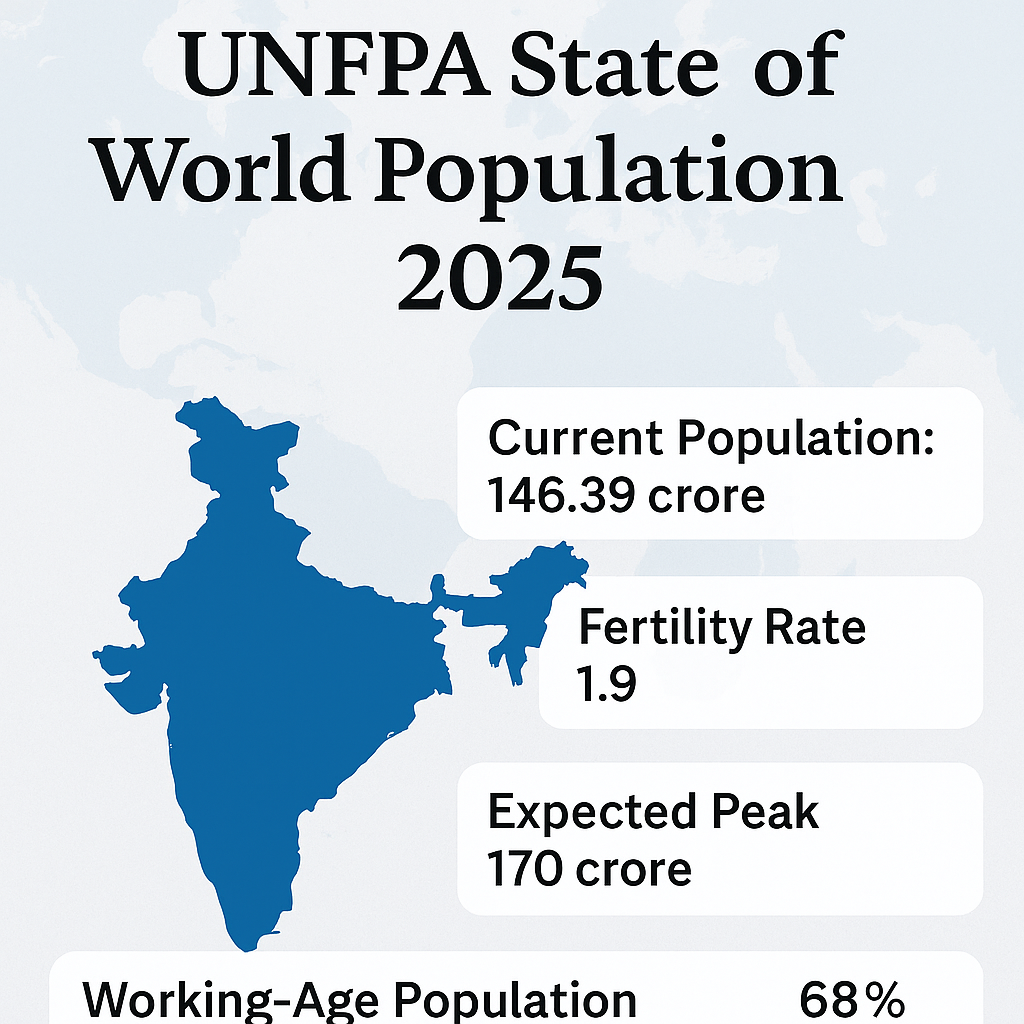
🧭June 15, 2025 Post 3: UNFPA Report: India’s Fertility Decline Signals a Demographic Transition | High Quality Mains Essay: India and Norway in the Blue Economy: Charting a Sustainable Course through Oceans and Diplomacy | For IAS-2026 :Prelims MCQs
India’s Demographic Turning Point: Reading Between the Numbers of Fertility Decline

Introduction
India’s demographic narrative has long been dominated by concerns of overpopulation, with policy efforts historically geared toward control, awareness, and contraception. However, the United Nations Population Fund’s (UNFPA) 2025 report, titled “The Real Fertility Crisis”, calls for a fundamental reframing of that discourse. With a Total Fertility Rate (TFR) of 1.9, India has officially slipped below the replacement level of 2.1, marking a critical transition from a population growth phase to one of stabilization. This shift is not merely statistical—it reflects broader social, economic, and health transformations, and also poses new policy challenges around ageing, workforce planning, and reproductive rights.
India’s Demographic Milestone: Key Data from the 2025 Report
- Population Size: India’s population is now 146.39 crore, surpassing China’s 141.61 crore, making it the most populous country on Earth.
- Future Projection: India’s population is expected to peak at 170 crore before entering a long-term decline, likely over the next four decades.
- TFR at 1.9: The fertility rate is now below replacement, indicating a natural stabilization of population growth.
- Demographic Composition:
- Working-age population (15–64): 68%
- Children (0–14): 24%
- Youth (10–24): 26%
- Elderly (65+): 7% (and rising)
The Real Fertility Crisis: Not Overpopulation, but Agency
The report’s subtitle, “The Real Fertility Crisis,” shifts focus from numbers to reproductive agency—the ability of individuals, particularly women, to make informed and voluntary decisions about their fertility. In many contexts, fertility decline is not a crisis, but a marker of social progress, provided it stems from choice, not compulsion or lack of access.
Key drivers include:
- Improved contraceptive access and maternal healthcare
- Rising female education and workforce participation
- Urbanization, where family sizes naturally shrink
- Economic uncertainty, which often delays or limits family size
The real challenge, the report argues, lies in ensuring that reproductive goals—whether to have children or not—are supported by policy, healthcare, and cultural norms.
Regional Disparities and Demographic Imbalance
While India’s national TFR is below 2.1, several states still have above-replacement fertility:
- Bihar: 2.98
- Meghalaya: 2.9
- Uttar Pradesh: 2.35
- Jharkhand: 2.26
- Manipur: 2.2
This regional divergence may lead to:
- Internal migration, as working-age populations from high-TFR states move to lower-TFR, economically advanced regions.
- Cultural friction and resource strain in receiving states
- Uneven demand for education, jobs, and public services
The demographic future will thus not be uniform across India—it will be fractured, dynamic, and policy-sensitive.
Positive Implications of the Fertility Decline
1. Population Stabilization
A TFR of 1.9 signals that India is on the cusp of natural population stabilization. This can:
- Ease pressure on land, water, and public infrastructure
- Allow for better per capita access to health and education
- Support environmental sustainability goals
2. Improved Maternal & Child Health
Fewer childbirths per woman, often at later ages, result in:
- Lower maternal mortality rates
- Healthier children with better nutrition and care
- More time for education and economic participation
3. Women’s Empowerment
Fertility decline correlates with:
- Higher female literacy
- Increased labour force participation
- Greater autonomy over life decisions
- Delayed marriages and more space for self-actualization
Challenges on the Horizon
1. Ageing Population
A sustained fertility decline leads to population ageing. As the elderly population grows:
- Dependency ratios rise, burdening the working-age population
- There is increased pressure on healthcare, pensions, and caregiving infrastructure
- India may face scenarios akin to Japan and China, where economic stagnation followed demographic greying
2. Skewed Sex Ratios
In regions with patriarchal bias, declining fertility may incentivize sex-selective practices:
- Leads to imbalanced sex ratios, social tensions, and rising gender-based violence
- Reinforces son preference, harming long-term gender equality
3. Policy Unpreparedness
India lacks:
- A robust social security net for the elderly
- Pension coverage for informal sector workers
- Public health readiness for managing non-communicable diseases associated with ageing
Global Context: Fertility Decline as a Global Norm
India’s experience is not isolated. Many countries face similar transitions:
- Japan: Median age over 48 years; stagnant economy; shrinking workforce
- China: Effects of the one-child policy have led to a declining, ageing population
- South Korea: TFR at 0.78—one of the lowest globally, with negative population growth
These countries show that delayed policy responses can deepen economic and social risks.
India at a Crossroads: What Should Be Done?
India’s demographic transition is not a problem—it is an opportunity. The goal should not be to reverse the decline, but to prepare for its consequences while ensuring reproductive freedom remains central.
Policy Recommendations:
- Invest in Elderly Care
- Expand public health programs for senior citizens
- Promote home-based care, old-age homes, and geriatric education
- Enhance Women’s Choices
- Ensure affordable, non-coercive access to contraception
- Promote comprehensive sex education
- Encourage flexible work environments and maternity benefits
- Regional Population Policy
- Customize interventions based on local TFR
- Prevent coercive or discriminatory measures in high-fertility states
- Manage migration and urban planning in low-TFR states
- Prepare the Workforce
- Upskill India’s massive youth population before it ages
- Encourage automation and technology to offset future labour shortages
- Integrate informal workers into pension and insurance schemes
Conclusion
The UNFPA’s 2025 report challenges us to move beyond population control and embrace population planning anchored in rights, sustainability, and readiness. India is no longer racing against overpopulation—it is negotiating a new demographic equilibrium, where dignity, freedom, and foresight must shape public policy.
As India’s demographic window begins to close in the coming decades, its ability to translate youth potential into productive capacity—while safeguarding its elderly and empowering its women—will determine not just national prosperity, but the moral fabric of its growth story.
🪔 Closing Whisper — by IAS Monk
“Demography is not just destiny—it is a reflection of the dreams, choices, and freedoms a society allows its people.”
UNFPA Report: India’s Fertility Decline Signals a Demographic Transition
NATIONAL HERO — PETAL 003
📅 Date: June 15, 2025
📘 Thematic Focus: GS1 – Human Geography | GS2 – Health & Social Policy | GS3 – Demographics & Economy
🌀 Opening Whisper
“The real fertility crisis lies not in the numbers, but in the quiet freedoms people are denied.”
🔍 Key Highlights from UNFPA’s 2025 Report: “The Real Fertility Crisis”
- India’s population is now estimated at 146.39 crore, officially the world’s most populous country, surpassing China (141.61 crore).
- Fertility Rate (TFR): Stands at 1.9, below the replacement level of 2.1, indicating population stabilization.
- Peak Projection: India’s population is expected to peak at 170 crore before gradually declining in 40 years.
- Demographic Composition:
- Working-age (15–64 yrs): 68%
- Children (0–14 yrs): 24%
- Youth (10–24 yrs): 26%
- Elderly (65+ yrs): 7% (projected to rise)
- High-TFR States:
- Bihar (2.98), Meghalaya (2.9), Uttar Pradesh (2.35), Jharkhand (2.26), Manipur (2.2)
- Core Insight:
The “real fertility crisis” is not overpopulation or underpopulation—
but the lack of reproductive agency: the freedom to make informed, voluntary choices about childbearing.
📘 Concept Explainer: Total Fertility Rate (TFR)
- TFR is the average number of children a woman is expected to have during her reproductive years (15–49).
- A TFR of 2.1 is considered the replacement level for population stability.
- India’s declining TFR reflects:
- Better reproductive healthcare access
- Female education & employment
- Urbanization and economic pressures
- Rising age at marriage
🧭 GS Mains Mapping
- GS Paper 1 – Human Geography | Population Trends | Regional Variations
- GS Paper 2 – Health Policy | Women & Child Welfare | Demographic Rights
- GS Paper 3 – Inclusive Growth | Social Justice | Sustainable Development Goals
- Essay – “Population is Power Only When Coupled with Planning and Freedom”
💭 A Thought Spark — by IAS Monk
“A falling birth rate may whisper progress, but also demands new compassion for the old, the young, and the unseen.”
High Quality Mains Essay For Practice :
Word Limit 1000-1200
India’s Demographic Turning Point: Reading Between the Numbers of Fertility Decline
Introduction
India’s demographic narrative has long been dominated by concerns of overpopulation, with policy efforts historically geared toward control, awareness, and contraception. However, the United Nations Population Fund’s (UNFPA) 2025 report, titled “The Real Fertility Crisis”, calls for a fundamental reframing of that discourse. With a Total Fertility Rate (TFR) of 1.9, India has officially slipped below the replacement level of 2.1, marking a critical transition from a population growth phase to one of stabilization. This shift is not merely statistical—it reflects broader social, economic, and health transformations, and also poses new policy challenges around ageing, workforce planning, and reproductive rights.
India’s Demographic Milestone: Key Data from the 2025 Report
- Population Size: India’s population is now 146.39 crore, surpassing China’s 141.61 crore, making it the most populous country on Earth.
- Future Projection: India’s population is expected to peak at 170 crore before entering a long-term decline, likely over the next four decades.
- TFR at 1.9: The fertility rate is now below replacement, indicating a natural stabilization of population growth.
- Demographic Composition:
- Working-age population (15–64): 68%
- Children (0–14): 24%
- Youth (10–24): 26%
- Elderly (65+): 7% (and rising)
The Real Fertility Crisis: Not Overpopulation, but Agency
The report’s subtitle, “The Real Fertility Crisis,” shifts focus from numbers to reproductive agency—the ability of individuals, particularly women, to make informed and voluntary decisions about their fertility. In many contexts, fertility decline is not a crisis, but a marker of social progress, provided it stems from choice, not compulsion or lack of access.
Key drivers include:
- Improved contraceptive access and maternal healthcare
- Rising female education and workforce participation
- Urbanization, where family sizes naturally shrink
- Economic uncertainty, which often delays or limits family size
The real challenge, the report argues, lies in ensuring that reproductive goals—whether to have children or not—are supported by policy, healthcare, and cultural norms.
Regional Disparities and Demographic Imbalance
While India’s national TFR is below 2.1, several states still have above-replacement fertility:
- Bihar: 2.98
- Meghalaya: 2.9
- Uttar Pradesh: 2.35
- Jharkhand: 2.26
- Manipur: 2.2
This regional divergence may lead to:
- Internal migration, as working-age populations from high-TFR states move to lower-TFR, economically advanced regions.
- Cultural friction and resource strain in receiving states
- Uneven demand for education, jobs, and public services
The demographic future will thus not be uniform across India—it will be fractured, dynamic, and policy-sensitive.
Positive Implications of the Fertility Decline
1. Population Stabilization
A TFR of 1.9 signals that India is on the cusp of natural population stabilization. This can:
- Ease pressure on land, water, and public infrastructure
- Allow for better per capita access to health and education
- Support environmental sustainability goals
2. Improved Maternal & Child Health
Fewer childbirths per woman, often at later ages, result in:
- Lower maternal mortality rates
- Healthier children with better nutrition and care
- More time for education and economic participation
3. Women’s Empowerment
Fertility decline correlates with:
- Higher female literacy
- Increased labour force participation
- Greater autonomy over life decisions
- Delayed marriages and more space for self-actualization
Challenges on the Horizon
1. Ageing Population
A sustained fertility decline leads to population ageing. As the elderly population grows:
- Dependency ratios rise, burdening the working-age population
- There is increased pressure on healthcare, pensions, and caregiving infrastructure
- India may face scenarios akin to Japan and China, where economic stagnation followed demographic greying
2. Skewed Sex Ratios
In regions with patriarchal bias, declining fertility may incentivize sex-selective practices:
- Leads to imbalanced sex ratios, social tensions, and rising gender-based violence
- Reinforces son preference, harming long-term gender equality
3. Policy Unpreparedness
India lacks:
- A robust social security net for the elderly
- Pension coverage for informal sector workers
- Public health readiness for managing non-communicable diseases associated with ageing
Global Context: Fertility Decline as a Global Norm
India’s experience is not isolated. Many countries face similar transitions:
- Japan: Median age over 48 years; stagnant economy; shrinking workforce
- China: Effects of the one-child policy have led to a declining, ageing population
- South Korea: TFR at 0.78—one of the lowest globally, with negative population growth
These countries show that delayed policy responses can deepen economic and social risks.
India at a Crossroads: What Should Be Done?
India’s demographic transition is not a problem—it is an opportunity. The goal should not be to reverse the decline, but to prepare for its consequences while ensuring reproductive freedom remains central.
Policy Recommendations:
- Invest in Elderly Care
- Expand public health programs for senior citizens
- Promote home-based care, old-age homes, and geriatric education
- Enhance Women’s Choices
- Ensure affordable, non-coercive access to contraception
- Promote comprehensive sex education
- Encourage flexible work environments and maternity benefits
- Regional Population Policy
- Customize interventions based on local TFR
- Prevent coercive or discriminatory measures in high-fertility states
- Manage migration and urban planning in low-TFR states
- Prepare the Workforce
- Upskill India’s massive youth population before it ages
- Encourage automation and technology to offset future labour shortages
- Integrate informal workers into pension and insurance schemes
Conclusion
The UNFPA’s 2025 report challenges us to move beyond population control and embrace population planning anchored in rights, sustainability, and readiness. India is no longer racing against overpopulation—it is negotiating a new demographic equilibrium, where dignity, freedom, and foresight must shape public policy.
As India’s demographic window begins to close in the coming decades, its ability to translate youth potential into productive capacity—while safeguarding its elderly and empowering its women—will determine not just national prosperity, but the moral fabric of its growth story.
🪔 Closing Whisper — by IAS Monk
“Demography is not just destiny—it is a reflection of the dreams, choices, and freedoms a society allows its people.”
Target IAS-26: Daily MCQs :
📌 Prelims Practice MCQs
Topic: UNFPA Report: India’s Fertility Decline Signals a Demographic Transition
MCQ 1 – Type 1: How many of the above statements are correct?
Consider the following statements regarding India’s population trends as per the UNFPA 2025 Report:
1. India’s Total Fertility Rate (TFR) is currently above the replacement level.
2. The elderly population (65+) in India is currently below 10% but is expected to rise.
3. The report highlights reproductive agency as central to fertility decisions.
4. India’s population is projected to decline within the next 10 years.
How many of the above statements are correct?
A) Only two
B) Only three
C) All four
D) Only one
🌀 Didn’t get it? Click here (▸) for the Correct Answer & Explanation
✅ Correct Answer: A) Only two
🧠 Explanation:
•1) ❌ False – India’s TFR is 1.9, which is below the replacement level of 2.1.
•2) ✅ True – The elderly population is 7%, and it’s expected to increase.
•3) ✅ True – The report highlights reproductive agency as the core of fertility freedom.
•4) ❌ False – The decline is projected to begin in 40 years, not within 10.
MCQ 2 – Type 2: Two Statements Based
Consider the following two statements regarding India’s demographic trends:
1. India’s working-age population (15–64 years) currently forms less than 50% of the total population.
2. Total Fertility Rate (TFR) of 2.1 is considered the replacement level for a stable population.
Which of the above statements is/are correct?
A) Only 1 is correct
B) Only 2 is correct
C) Both are correct
D) Neither is correct
🌀 Didn’t get it? Click here (▸) for the Correct Answer & Explanation
✅ Correct Answer: B) Only 2 is correct
🧠 Explanation:
•1) ❌ False – India’s working-age population is 68%, which is much more than 50%.
•2) ✅ True – A TFR of 2.1 is indeed the replacement level for population stability.
MCQ 3 – Type 3: Which of the statements is/are correct?
Which of the following statements are correct with respect to global fertility and population trends?
1. Japan’s median age has crossed 48, leading to a shrinking workforce.
2. South Korea’s fertility rate is one of the highest in the OECD.
3. China’s one-child policy contributed to its rapidly aging population.
4. The UNFPA 2025 report emphasizes overpopulation as the primary crisis.
Choose the correct option using the codes below:
A) 1 and 2 only
B) 1 and 3 only
C) 1, 3, and 4 only
D) 2, 3, and 4 only
🌀 Didn’t get it? Click here (▸) for the Correct Answer & Explanation
✅ Correct Answer: B) 1 and 3 only
🧠 Explanation:
•1) ✅ True – Japan’s median age is over 48, causing labor and economic pressures.
•2) ❌ False – South Korea has one of the lowest fertility rates in the OECD (0.78).
•3) ✅ True – China’s one-child policy contributed to rapid aging.
•4) ❌ False – The report focuses on reproductive agency, not overpopulation.
MCQ 4 – Type 4: Direct Fact
What is the current estimated population of India according to the UNFPA State of World Population 2025 report?
A) 140.45 crore
B) 146.39 crore
C) 150.21 crore
D) 141.61 crore
🌀 Didn’t get it? Click here (▸) for the Correct Answer & Explanation.
✅ Correct Answer: B) 146.39 crore
🧠 Explanation:
•The report states that India’s population has reached 146.39 crore as of April 2025, surpassing China and placing India as the most populous nation in the world.


















